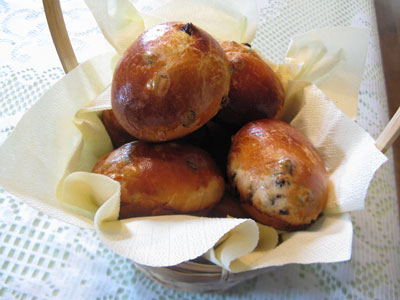breadsong's blog
Sun Food / pane di sole
Hello everyone,
Continuing to be inspired by Beth Hensperger’s beautiful book, Bread For All Seasons…
the next chapter begins with June and is titled ‘Sun Food’.
I’ve baked three breads of Italian origin over the last while, using ‘yellow-colored’ flours -
thinking about 'sun food' (sun bread), I wanted to call these breads ‘pane di sole’ :^)
Micca di enkir e buratto
Susan's Blueberry Sourdough Scones
Hello everyone,
I had some extra starter (wheat, rye, durum) ... and yesterday, saw Susan's post featuring lovely Blueberry Sourdough Scones.
Mixed some up last night and froze them; baked fresh this morning - Yum :^)
Thanks, Susan, for a delicious recipe and great way to use extra starter!
Shepherd's Bread
Hello everyone,
Shepherd’s Bread, from Beth Hensperger’s book Bread for all Seasons, is the May challenge for the Bread Baking Babes baking group.
Thank you to Karen of Bake My Day for hosting the challenge - this bread caught my interest, seeing the beauty of
Karen's loaves and having enjoyed reading Ms. Hensperger’s book :^)
Granville Island Beer Bread
Hello everyone,
When checking out last Friday’s Yeastspotting post, I saw two posts for Granville Island Beer Bread
(both breads looked fantastic!).
Looking at the posts, I saw The Bread Baking Babes selected this bread for the April challenge.
Granville Island Brewing’s beers are available at a nearby store (perfect!) –
I thought it would be fun to pick up some of this beer and participate in this month’s challenge :^)
Egg Rolls :^)
Hello, and best wishes to everyone this holiday weekend!
Sylvia just posted about her lemon-currant Panesiglio Aversano. Weren’t they gorgeous?!
Thank you, Sylvia, for baking these and sharing how you made them!
Those lemon-currant rolls were so pretty, and the flavor sounded so fresh and spring-like –
I knew I would have to make some for Easter :^)
Pain d'épices
Hello,
Browsing through an old baking text (Professional Baking by Mr. Wayne Gisslen), I was so happy to find a gingerbread formula with a pain d’épices variation – which included 50% rye flour (!).
This bake is for MC, who kindly gave me some beautiful Fairhaven whole rye flour, which I used in this bread :^)